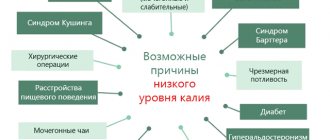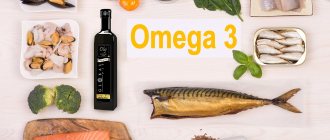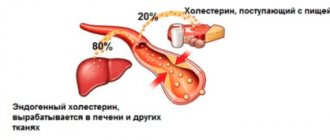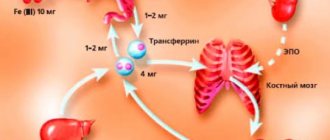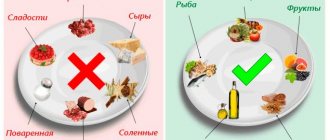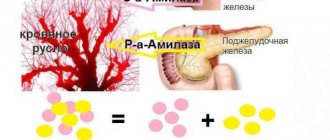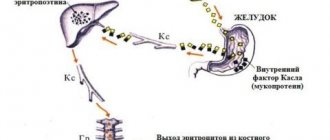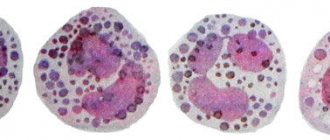What is the importance of iron
Iron is not synthesized by the body itself, so it is necessary to obtain its norm from the diet.
Iron is part of hemoglobin, which serves as a building material for red blood cells that carry oxygen from the lungs to other organs and tissues, simultaneously ridding them of carbon dioxide. And since every cell of the human body needs cellular respiration, iron can rightfully be called one of the most important elements.
Hemoglobin synthesis accounts for up to 70% of all iron entering the body. The remaining amount is stored in tissues and is used by the body to solve other necessary functions - for metabolic processes, to maintain the body’s immune system, for the healthy functioning of the thyroid gland and for the “construction” of connective tissue.
Most animal products are rich in iron:
- meat (beef, lamb, pork);
- meat by-products (especially liver);
- Fish and seafood;
- poultry meat (chicken, turkey).
The iron present in these foods is called hemoglobin. This is the most biologically available source of iron for the body, since it is absorbed much more efficiently than non-heme plant sources.
Iron for vegetarians
What about those who adhere to a vegan diet? Fortunately, iron is found not only in meat and food of animal origin. A selection of iron-containing products is also available for vegetarians. Iron obtained from plant foods is called non-hemoglobin (or non-heme).
These foods include legumes (peas, lentils, chickpeas), tofu cheese and soy products, nuts (especially peanuts) and wheat bran, greens (spinach, beet tops), cereals (buckwheat, barley and pearl barley), dried fruits, apples, mushrooms, seaweed.
Plant sources of iron are absorbed less efficiently. The percentage of their digestibility varies in the range of 2-20% of the amount of iron actually contained in the product, while in hemoglobin iron this figure reaches up to 35%.
However, there are a number of ways to improve your body's ability to absorb even non-heme iron.
Iron absorption
The amount of iron the body can absorb at one time is limited, so it is advisable to spread the consumption of iron-rich foods throughout the day.
To improve iron absorption, make sure that your daily diet contains the following vitamins and minerals, which act as activators of its absorption process:
- Vitamin C. It promotes the absorption of non-heme iron by more than 50 percent, so the daily menu must include foods containing it - berries, citrus fruits, kiwi, pineapples, broccoli and tomatoes.
- Vitamin A. With a deficiency of vitamin A, iron will also not be absorbed and used for tissue life support. Vitamin A is contained in most orange and yellow fruits and vegetables - dried apricots, carrots, bell peppers, pumpkin.
- Folic acid. It promotes the absorption of iron and normalizes the functioning of the digestive system. The list of foods containing folic acid includes eggs, soy products, brewer's and confectionery yeast, herbs, vegetables (tomatoes, cabbage, eggplant).
Some products contain certain compounds that hinder the absorption of iron.
You should not consume foods containing calcium at the same time as iron, as these two elements interfere with the absorption of each other. For lovers of dairy products, it is recommended to consume them separately from iron-containing ones - no earlier than after two hours.
Tannin contained in coffee and tea also prevents iron from being absorbed. Therefore, coffee lovers often experience iron deficiency. A useful and healthy alternative would be to consume freshly squeezed fruit or vegetable juices, or dried fruit compote.
How to increase iron in the blood correctly?
Before you go to the pharmacy to buy medications containing this element, or start looking at lists of food products that contain it, there are several points to take into account. Firstly, it is likely that there are sources of iron in your diet, but for some reason it is not absorbed. This often happens if the menu is unbalanced and lacks:
- ascorbic acid;
- vitamin B12.
These elements are responsible for the proper absorption of iron, and protein must always enter the body directly for the synthesis of hemoglobin: without this amino acid, there is also no point in increasing iron levels. In addition, the absorption of iron can be interfered with by taking it simultaneously with sources of calcium: as a result, your body will not receive either one or the other. The main foods containing calcium are representatives of the dairy group, so you should not combine them with sources of iron in one meal.
If we talk about how to increase iron in the blood by regular diet correction (this method is suitable for pregnant women who cannot take medication, children, the elderly, but will not have an effect if the deficiency is pronounced), then you should use more often:
- sauerkraut, kefir (contain vitamin B12);
- oranges, bell peppers, broccoli, lemons, tomatoes (sources of vitamin C).
But these are only helper products, which are an addition to more important ones that contain iron directly: from cereals there is buckwheat and oatmeal, from fruits pomegranates and persimmons, from vegetables spinach, beets and lentils. In addition, be sure to eat red meat: lamb, beef, turkey, all types of nuts, asparagus, prunes and dried apricots.
Daily requirement
For infants up to 6-12 months, the iron requirement is low, approximately 0.27 mg per day. This is due to the fact that they have an innate supply of this element. Children from one to three years old require about 7 mg of iron per day, from four to twelve years old - 8-10 mg. For teenagers, the average daily requirement for iron is 11 to 15 mg daily.
To eliminate iron deficiency in the body, adults need to receive at least 10 mg of this microelement from food, and the dosage for women is higher - from 15 to 18 mg. During pregnancy and lactation, the norm increases to 35 mg.
After approximately 45-50 years, iron levels for both sexes become equal - about 10 mg per day. This is due to the onset of menopause in women and the cessation of menstruation.
In some cases, the need for iron may exceed the above average characteristics. Iron in higher dosages is necessary for people who play sports or engage in heavy physical labor. In addition, the need for the amount of glands entering the body increases during recovery from injuries that resulted in heavy blood loss, and in the postoperative period, after infectious diseases, as well as for women during pregnancy and during the menstrual cycle.
Chronic iron deficiency can lead to iron deficiency anemia, a disease caused by a lack of red blood cells (RBCs) in the blood. Symptoms of this condition include weakness, chronic fatigue, frequent dizziness, especially when suddenly rising from a lying position, hair loss and brittle nails.
Foods High in Iron
As discussed above, dietary iron occurs in two forms: hemoglobin and non-heme. Plant foods contain only the non-hemoglobin type of iron, while animal products contain both forms.
Our body best absorbs iron obtained from meat (the percentage of absorption reaches 20 units), from fish and seafood (about 11%), legumes and cereals (up to 7%), and nuts (up to 6%). From other foods (fruits, vegetables and grains), only 1-3% of the stated iron content is absorbed.
Top list of iron-containing products
The human body is not able to synthesize iron, like some other trace elements and vitamins, it only processes it, obtaining it from red blood cells - erythrocytes. Therefore, it is so important to receive a daily dose of this microelement from a balanced and varied diet. Iron is found in significant concentrations in the following products.
Raisin
Raisins are a versatile food and easy to add to your diet. Not only does it contain B vitamins and potassium, but it is also an important source of iron. A handful of raisins contains approximately 1 mg of this trace element.
It can be used in baked goods, in fruit salads and desserts, or eaten on its own as a quick and nutritious snack.
Oysters
Oysters are not only rich in protein, but also have a high iron content. 100 grams of this seafood delicacy contains about 8.5 mg of iron, which is an excellent indicator.
Oysters can be eaten alive, sprinkled with lemon juice, or you can prepare delicious gourmet dishes from them. It could be oyster stew, or baked seafood with a creamy cheese crust.
Cashew
Nuts are perhaps the best food, especially for vegetarians, in terms of nutritional value, health benefits and iron content. In cashew nuts, its content is about 2 mg per average snack portion (about 30 grams of product). They also contain healthy fats that are essential for cardiovascular health.
You can eat them separately, for example, as a snack, or add them to any vegetable salad with herbs. They will add novelty and piquant taste to a familiar dish.
Beans
Beans have long taken the place of the main staple product in vegetarian menus due to their nutritional value and high protein content, a deficiency of which can often be experienced by people who give up meat. But it is also one of the leaders in iron content in its composition.
An average serving of cooked boiled or stewed beans contains about 4 mg of iron.
Beef
For meat eaters, beef is considered one of the best iron-containing foods. Not only meat fibers are rich in it, but also all offal, especially beef liver. 100 grams of beef contains about 3 mg of iron, while the same serving size of cooked beef liver contains about 9 mg.
Cereals
Cereals are another great option for getting your daily iron requirement. 100 grams of buckwheat contains about 5 mg of this microelement, wheat cereal - 4.7 mg, pearl barley - 1.8 mg, rice - 1 mg.
Spinach
In addition to vitamins A, C, K, B9, as well as potassium and magnesium, spinach is also a high concentration source of plant iron. Just one serving of cooked spinach leaves can provide up to 3 mg of iron, which is a quarter of an adult's daily requirement.
Heat treatment of spinach makes it easier to release and absorb iron during digestion, so it is recommended to consume it in stewed form.
Chocolate
Not every chocolate will supply your body with iron: dark chocolate occupies a leading position in the content of this microelement. Just one hundred-gram tile contains up to half of the “iron” daily requirement. This makes it possible, without exaggeration, to call dark chocolate the most delicious source of iron. In addition, it also contains magnesium, which is necessary for the nervous system to maintain calm.
Dark chocolate can be consumed on its own or added to baked goods and desserts. It is also useful to eat it with berries, for example, strawberries, which contain a lot of vitamin C, for better absorption of iron.
Lentils
In addition to being high in fiber and protein, lentils also contain a fair amount of iron. There are about 3 mg per 100 grams of raw, uncooked lentils.
Despite being nutritious, lentils are quite easy to prepare. Unlike many legumes, it does not require pre-soaking. At the same time, it cooks quite quickly - no more than 40 minutes.
Chickpeas
Chickpeas, or as they are also called, chickpeas, are a popular source of protein and iron in vegetarian menus. Its content per 100 g of uncooked raw product is about 2 mg. Chickpeas can be prepared as an independent side dish or mixed with other grains - for example, rice or wheat.
Eggs
Eating eggs is common not only for the availability of this product, but also for its numerous health benefits. Eggs are a source of pure, high-quality protein. At the same time, the iron content in them is also at the same level: one large egg contains about 1 mg of this microelement.
Chicken
Eating poultry and chicken by-products is a good way to increase your daily iron intake. White meat contains about 2 mg of iron per 100 grams of product, and dark meat contains up to 3 mg. Chicken liver is the richest source of iron, containing approximately 12 mg per 100 g serving.
Folk remedies
When treating anemia at home, you can prepare some folk remedies:
| Product | Application |
| Buckwheat | The product can be ground into powder and taken raw or cooked as porridge. |
| Beet | For anemia, it is recommended to take 20 ml of beet juice daily. In addition, the root vegetable can be eaten both raw and boiled. |
| Pomegranate | You should drink a glass of natural pomegranate juice every day. |
| Rose hip | You can prepare a decoction of rose hips by pouring boiling water over the berries and keeping the mixture in a thermos for several hours. |
| Honey with walnuts | It is necessary to mix honey and walnuts in equal quantities and eat 2 tablespoons of the product once a day. |
In addition, it is possible to get rid of anemia by consuming garlic daily. It is recommended to eat fresh cucumbers every day without peeling them. For prevention purposes, spinach helps, which can be added to various salads.
Foods High in Iron
Iron is found in large quantities in the following foods:
- pork liver
- pumpkin seeds
- beef
- mushrooms
- Brewer's yeast
- lentils
- sunflower seeds
- greenery
- sea fish
In addition, iron is found in most fruits, raisins, dried apricots, vegetables and nuts. The absorption of iron is improved by consuming fruits with vitamin C, apples and some types of berries.
Foods that interfere with iron absorption
The absorption of iron in the intestine is impaired by:
- calcium
- soy protein
- phytates
- dietary fiber
The process of iron absorption can be disrupted by calcium and phosphorus salts, as well as cheese and milk. When eating food that contains iron, it is not recommended to drink it with milk.
Experts recommend avoiding tea and coffee, as they contain tannins that interfere with the absorption of iron.
Iron absorption can be significantly reduced by phytins, which are found in cereals such as bread. Products containing iron are not allowed to be consumed simultaneously with potatoes, rice, and eggs.
Example of a daily diet
Products rich in iron and vitamins that promote its absorption are publicly available and can be purchased at any store. Here is an example of a daily diet with the following products:
Breakfast: egg dish (omelet, fried egg) or oatmeal with dried fruits, whole grain bread sandwich with cheese, citrus juice.
Snack: nuts, apple.
Lunch: Soup with meat or mushroom broth, stewed liver in sour cream with onions and carrots or baked beef with steamed broccoli, dried fruit compote.
Dinner: Baked meat or fish, side dish - buckwheat or stewed cabbage with tomatoes, salad of herbs and vegetables.
This type of nutrition not only contains a sufficient amount of iron, vitamins C, A, group B, including folic acid, and copper, but also fully fits the definition of proper nutrition.
Iron-deficiency anemia
Often tests reveal not just a lack of iron, but a more serious problem - iron deficiency anemia. It is often diagnosed in people who have suffered heavy blood loss during injury or surgery. As a rule, anemia is a concomitant condition associated with diseases of the digestive system, with the development of malignant and benign tumors, and with frequent chronic internal bleeding (ulcers, hemorrhoids).
Iron deficiency anemia is diagnosed when hemoglobin levels decrease to 70-100 g/l, and ferritin levels drop below 15 ng/ml.
If you have anemia, self-medication and self-prescription are strictly prohibited. The doctor selects treatment depending on the severity of anemia. In milder forms, therapy with multivitamin complexes with an increased iron content in the composition is possible, and in advanced cases, special drugs are prescribed - potent drugs that have various side effects. Such medications can only be taken for a short term course under the supervision of a physician.
What to consider when preparing dishes
If the level of iron in the blood is low, it is important not only to select the right foods, but also to prepare them correctly. To ensure that food does not lose its beneficial properties, you should follow simple cooking rules. It is recommended to cook porridge and soups in cast iron dishes with a thick bottom. It is believed that such utensils increase the iron content in ready-made dishes by 15–20%.
Fans of milk porridges should cook them in water and add milk after cooking. Another important rule is limiting the amount of salt in the diet. Its excess leads to disruption of the absorption of beneficial microelements. Greens should be added fresh to dishes.
Iron supplements
The only justified indication for taking iron-containing drugs is a severe deficiency of this microelement in the body.
Iron preparations include both medicines and vitamin-mineral complexes. Each of them has its own scope of application and is suitable for a certain severity of the disease. Let's take a closer look.
When, based on the results of blood tests, a diagnosis of iron deficiency anemia is made, the attending physician prescribes a course of iron supplements. There are several types of such drugs, differing in their active substance composition, dosage and release form.
Medicines may contain divalent or trivalent iron salts. In the first case, sulfite or sulfate is most often used in the composition, in the second - drugs containing a polymaltase complex. The advantage of the latter is the lower number of side effects such as nausea, dizziness, and indigestion.
If we are talking about only minor iron deficiency, then you can get by with dietary supplements. They can be taken when symptoms such as increased fatigue, decreased concentration, irritability, and deterioration in the condition of hair and nails appear.
Vitamin and mineral supplements typically contain up to 18 mg of iron and can be taken without the risk of overdose or side effects. Such drugs are often prescribed to children and adolescents during periods of active growth, as well as to pregnant women.
Attention! If you take additional iron complexes, do not forget to take a blood test from time to time to prevent an overabundance of this element. It is almost impossible to get too much iron from food, but uncontrolled intake of dietary supplements and vitamin complexes can lead to an excessive increase in iron levels in the blood.
As mentioned above, severe iron deficiency can lead to anemia, which is a consequence of a decrease in the concentration of hemoglobin levels in the blood. The main symptoms include chronic fatigue, pale skin, severe shortness of breath even with moderate physical exertion.
The consequences of less severe iron deficiency are less well understood. However, it has been noted that even a slight lack of iron in the body reduces the intensity of physical and mental performance and leads to a weakening of the immune system, expressed in weak resistance to viruses and infections.
An excess of iron is no less dangerous. Medical evidence suggests a relationship between excess iron and the development of cardiovascular diseases, diabetes, and even contributes to the growth of malignant tumors.
That is why it is so important to monitor the balance and variety of your diet to maintain the health and functional functioning of all body systems.
Why is there a shortage?
Low iron levels are caused by many factors. The causes of microelement deficiency are as follows:
- unbalanced diet;
- diseases of the hematopoietic system;
- stress, emotional overstrain;
- diets for weight loss;
- impaired absorption of iron by the intestine.
Iron is poorly absorbed by the intestinal walls during gastritis, ulcers, dysbacteriosis and other diseases. Anemia (lack of hemoglobin in the blood) often develops due to iron deficiency. There are many causes of the disease, regardless of them, when a problem appears, it is important to begin timely treatment.

